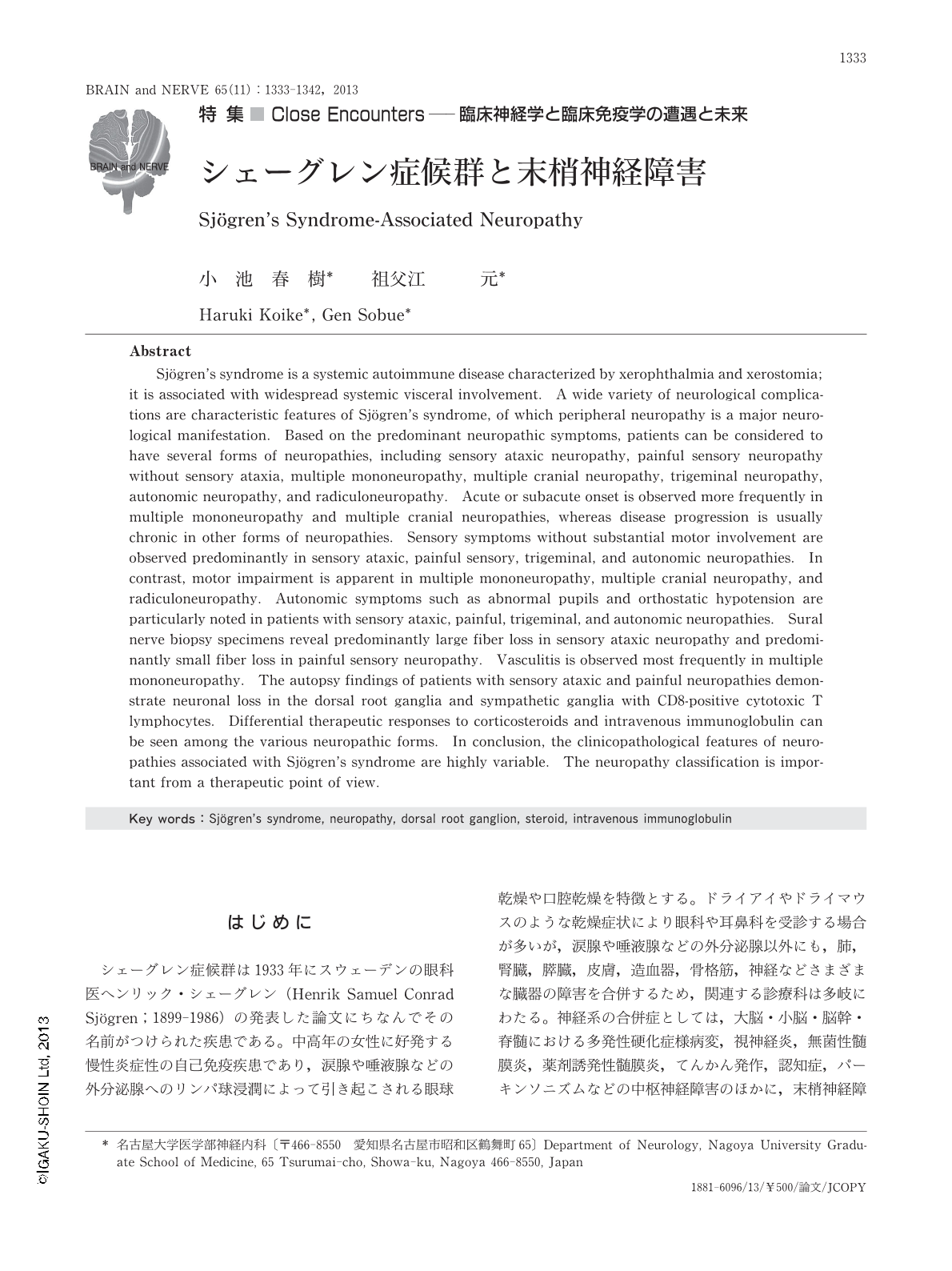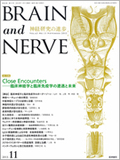Japanese
English
- 有料閲覧
- Abstract 文献概要
- 1ページ目 Look Inside
- 参考文献 Reference
- サイト内被引用 Cited by
はじめに
シェーグレン症候群は1933年にスウェーデンの眼科医ヘンリック・シェーグレン(Henrik Samuel Conrad Sjögren;1899-1986)の発表した論文にちなんでその名前がつけられた疾患である。中高年の女性に好発する慢性炎症性の自己免疫疾患であり,涙腺や唾液腺などの外分泌腺へのリンパ球浸潤によって引き起こされる眼球乾燥や口腔乾燥を特徴とする。ドライアイやドライマウスのような乾燥症状により眼科や耳鼻科を受診する場合が多いが,涙腺や唾液腺などの外分泌腺以外にも,肺,腎臓,膵臓,皮膚,造血器,骨格筋,神経などさまざまな臓器の障害を合併するため,関連する診療科は多岐にわたる。神経系の合併症としては,大脳・小脳・脳幹・脊髄における多発性硬化症様病変,視神経炎,無菌性髄膜炎,薬剤誘発性髄膜炎,てんかん発作,認知症,パーキンソニズムなどの中枢神経障害のほかに,末梢神経障害(ニューロパチー),筋炎など,多彩な神経障害をきたすことが知られている1,2)。欧米の疫学調査では成人女性有病率は0.6~4.8%であるのに対し,1994年に行われた旧厚生省によるわが国の調査では女性の0.026%,長崎の原子爆弾被爆者の調査では被爆による影響を考慮する必要があるが2.3%が罹患しているといわれている3)。
ニューロパチーはシェーグレン症候群に伴う神経障害の中でも最も古くから報告されており,シェーグレン自身による原著において既に顔面神経麻痺,顔面の知覚障害についての記載がなされている。初期にはニューロパチーの原因は主に血管炎と考えられていたが,1986年にMalinowら4)によって後根神経節への炎症性細胞浸潤と,それに伴う神経細胞脱落によって感覚性運動失調型ニューロパチーが惹起されることが示され,シェーグレン症候群においては神経節が病態発現のターゲットであるという考え方が主流となった1,5,6)。このことによってシェーグレン症候群の中では感覚性運動失調型ニューロパチーが注目を集めることになったが,近年の研究により,シェーグレン症候群に伴うニューロパチーは多彩な病型を呈することが明らかになっている1,7)。
本稿では,シェーグレン症候群におけるニューロパチーについて,臨床病理像の多様性,鑑別診断,治療などを中心に述べる。
Abstract
Sjögren's syndrome is a systemic autoimmune disease characterized by xerophthalmia and xerostomia; it is associated with widespread systemic visceral involvement. A wide variety of neurological complications are characteristic features of Sjögren's syndrome, of which peripheral neuropathy is a major neurological manifestation. Based on the predominant neuropathic symptoms, patients can be considered to have several forms of neuropathies, including sensory ataxic neuropathy, painful sensory neuropathy without sensory ataxia, multiple mononeuropathy, multiple cranial neuropathy, trigeminal neuropathy, autonomic neuropathy, and radiculoneuropathy. Acute or subacute onset is observed more frequently in multiple mononeuropathy and multiple cranial neuropathies, whereas disease progression is usually chronic in other forms of neuropathies. Sensory symptoms without substantial motor involvement are observed predominantly in sensory ataxic, painful sensory, trigeminal, and autonomic neuropathies. In contrast, motor impairment is apparent in multiple mononeuropathy, multiple cranial neuropathy, and radiculoneuropathy. Autonomic symptoms such as abnormal pupils and orthostatic hypotension are particularly noted in patients with sensory ataxic, painful, trigeminal, and autonomic neuropathies. Sural nerve biopsy specimens reveal predominantly large fiber loss in sensory ataxic neuropathy and predominantly small fiber loss in painful sensory neuropathy. Vasculitis is observed most frequently in multiple mononeuropathy. The autopsy findings of patients with sensory ataxic and painful neuropathies demonstrate neuronal loss in the dorsal root ganglia and sympathetic ganglia with CD8-positive cytotoxic T lymphocytes. Differential therapeutic responses to corticosteroids and intravenous immunoglobulin can be seen among the various neuropathic forms. In conclusion, the clinicopathological features of neuropathies associated with Sjögren's syndrome are highly variable. The neuropathy classification is important from a therapeutic point of view.

Copyright © 2013, Igaku-Shoin Ltd. All rights reserved.


